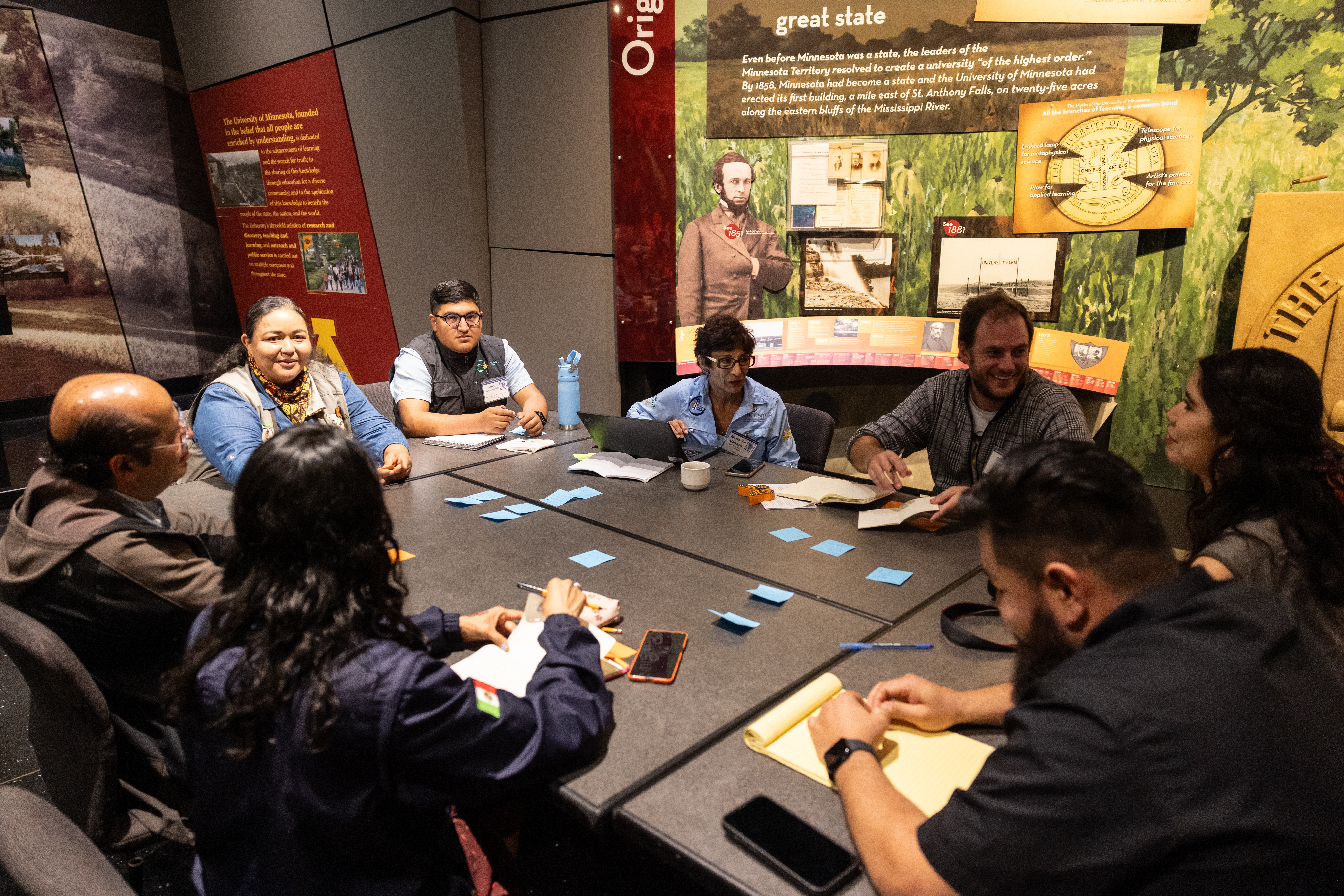Highlights from the 2025 Monarch Summits in Minnesota and Kansas by Bee Redfield, Conservation Director and Cody Wilson, Agricultural Manager, Pollinator Partnership
Published September 12, 2025
Imagine a tapestry woven across North America, stitched together by butterflies, scientists, and shared urgency. That is what unfolded this summer, when Pollinator Partnership’s Conservation Director Bee Redfield joined the Monarch Summit in Minnesota to dig into policy, innovation, and vision, while P2’s Agricultural Manager Cody Wilson headed to Kansas for the International Monarch Science Symposium to hear the latest scientific discoveries and dialogue. Together, these gatherings tell a larger story of where monarch conservation stands today and where it is headed next.
Breakout session at the Minnesota Summit. Photo by Rebecca Slater

All attendees at the Minnesota Summit. Photo by Rebecca Slater

Minnesota Summit Conference Room. Photo by Rebecca Slater

Reflections from the North American Monarch Summit – Minnesota, from Bee
The Monarch Summit in Minneapolis was one of those gatherings where you walk away with a binder full of notes and a head buzzing with big ideas. It felt like the whole monarch world, including scientists, community groups, policy folks, nonprofits, and land managers, all came together in one room to wrestle with the same question: what is next for monarchs, and how do we save them by working together?
Karen Oberhauser, Professor Emeritus of the UW-Madison Arboretum and one of the foremost voices in monarch conservation, opened with a reminder that none of this work started yesterday. Monarchs have been bringing us to the table together for more than 40 years, through trinational (Canada, Mexico, and the United States) meetings, science partnerships, and conservation plans that stretch across the continent. Her talk set the tone perfectly: these butterflies belong to no one country, and our efforts must be just as fluid as their flight paths.
The pesticide panel was one of the most eye-opening sessions for me. For years, pesticide regulation has hinged on the phrase “the label is the law.” But what happens when those labels do not reflect what is really happening in the field? The EPA’s new Insecticide Strategy is trying to move beyond that, using population-level models, mapping, and mitigation that makes more sense for species like monarchs. Hearing regulators, researchers, and even industry voices all grappling with this together was insightful and helped to build optimism for future talks.
Chip Taylor, founder of Monarch Watch and one of the pioneers of modern monarch research, reminded us that monarch populations do not decline in a neat, straight line. They crash, they rebound, and they shift with weather and climate in ways we only understand because thousands of volunteers have been out tagging, watching, and recording for decades. Community science is not just “feel-good engagement;” it is the backbone of how we even know what is happening in our field. Without those long-term, widespread data sets, we would be “flying blind.”
Cheryl Schultz of Washington State University, in collaboration with The Xerces Society, shared the exciting release of a new national report called the State of the Butterflies in the United States: A Roadmap for Butterfly Conservation in the 21st Century. At 94 pages long, it lays out where we stand and where we need to go, turning many scattered efforts around the globe into a coordinated vision for butterfly conservation in the decades ahead.
One of the most unexpected gems came from Texas, where James Tracy and his team tested “flight diverters” to help monarchs cross highways safely. Picture simple structures nudging butterflies to fly just a little higher over traffic and reducing roadkill by nearly 50 percent. It is the kind of practical, local innovation that makes you think: if we can fix this problem, what else could we rethink in our designed landscapes?
Cuauhtémoc Sáenz Romero’s talk about work being done in Mexico gave me chills (the good kind). With climate models showing that the fir trees monarchs depend on for winter roosts may not survive in their current range, his team is planting new stands upslope, essentially building tomorrow’s forests today. It is bold, daunting, and exactly the kind of forward-thinking that monarchs will need in the decades ahead.
Lee Walston from Argonne National Lab reminded us that solutions can pull double duty. By tweaking how solar farms are designed and managed, through factors such as panel height, mowing, and seed mixes, they can become excellent habitats for monarchs and other pollinators. The image of monarchs floating between solar panels stuck with me: energy and ecology humming side by side.
It was also fun to see how meticulous monarch science can get. One presentation by Leone Brown of James Madison University explored different adhesives used for monarch tagging, testing which materials were safest and most durable. Research showed that eyelash glue led to the lowest mortality and the best tag retention on monarchs. It might sound like a small thing, but these kinds of details make all the difference between reliable data and lost opportunities.
Another presentation by Emily Geest of Oklahoma City Zoo looked at community buy-in for monarch habitat. A zoo-based program invited guests to plant milkweed, and it turned out visitors were more likely to plant plugs over seeds, by a ratio of almost two to one, perhaps because it offered a more immediate sense of impact. It was a good reminder that when we design community planting programs, psychology matters just as much as ecology.
This year’s Summit was not just about new science, but about possibility. The sense was that we don’t have to choose between big systems change and small, local fixes. We need both. From policy rooms to prairie patches, monarchs are showing us the places where our human world collides with theirs. Every place we get creative is a place where monarchs get a little more room to survive and even thrive.
Reflections from the International Monarch Science Symposium – Kansas, from Cody
The International Monarch Science Symposium in Lawrence, Kansas was packed with curious minds all interested in one thing: Monarch butterflies. The symposium opened with thoughtful remarks from Chip Taylor founder of Monarch Watch, monarch expert entomologist William Calvert, Stephen Malcom of Western Michigan University, Tori Pocius of Pennsylvania State University, naturalist, author, and conservationist Robert Pyle, Ernest Williams of Hamiliton College, and Myron Zalucki of the University of Queensland on the legacy left behind by the late Lincoln Brower, which sparked intrigue, curiosity, and awe among those in attendance. The symposium then launched into a revolving door of presenters, with more than 45 presentations over the next day and a half on current monarch research. The following are just a few selections amongst topics discussed.
John Pleasants of Iowa State shared that while rearing greatly improves early-stage survival, from ~26% in the wild to ~82%, reared monarchs still only migrate at half the success of wild individuals. The net result? Reared butterflies are about 1.6 times more likely to reach Mexico. Still, even rearing half a million adds just a fraction of a percent to the overall migratory population. For many people, hand-rearing monarchs remains an entry point into conservation: it sparks curiosity, builds empathy, and gets kids and adults alike engaged with nature. At the same time, some in the scientific community worry that large-scale rearing could give a false sense of population recovery. It’s a reminder that while rearing has value as an educational tool, it can’t replace habitat protection and landscape-scale conservation.
Eduardo Rendon Salinas of the World Wildlife Fund, reported on long term monitoring as the key for the conservation of the Monarch butterfly in Mexico and North America. This monitoring has allowed for the ability to know where restoration efforts should be emphasized.
Cheryl Schultz of Washington State University discussed the importance of habitat heterogeneity during periods of extreme heat for monarch breeding in the arid west. Through study, there was found to be a greater average number of monarch eggs/stem in the shade than in areas with full sun. These amongst other results suggest enhancing miilkweed in and around shade structures and advocacy for habitat heterogeneity and habitat structure.
Gail Morris, Monarch Watch Conservation Specialist, presented on divergent migration destinations and overwintering strategies of Danaus plexippus in the southwest United States, finding that even during a record heat wave in Phoenix in December, radio tagged monarchs were observed mating.
Niranjana Krishnan of the University of Maryland, discussed her work on pesticide toxicity and risk as she addresses the question, “Can we practice crop production and conservation at the same time and place?”
Christopher Brown of Bayer Crop Science, presented on the development of insect-protected genetically engineered crops using a safe by design approach and a thorough environmental risk assessment.
Matthew Bolek of Oklahoma State University, discussed the important research on distribution and transmission mechanisms of Ophryocystis elektroscirrha (Oe) in monarch butterflies. Oe is a protozoan parasite that infects monarch butterflies. Through investigative analysis, Dr. Bolek lays important groundwork for understanding monarch mortality and parasitic infection.
Micah Freedman of the University of Toronto examined using cardenolide fingerprinting to infer natal host plants and geographical origins of western monarch butterflies. Each species of milkweed fed on by a monarch leaves a unique cardenolide or chemical marker with the butterfly. The collection of these markers creates a “fingerprint”. These cardenolide fingerprints can provide information on host use and natal origins of the monarch butterflies. It was found that a high proportion of monarchs at California overwintering sites have fingerprints matching a non-native milkweed, Asclepias curassavica, whereas butterflies associated with A. speciosa, are long-distance migrants and appear to have a higher overwintering survival.
Nancy Lawson, author, presented on “Monarch Rx” - a participatory project with challenges, as well as presenting for Michael Boppre, University of Freiberg, on the chemoecology of monarch butterflies. Both presentations addressed the knowledge gap in monarch pharmacophagy, the consumption of plants to sequester beneficial chemicals rather than for nutritional purposes. Whereas the use of milkweed as a hostplant for monarch larva is clearly heavily examined, adult monarchs have been found exhibiting, what appears to be, pharmacophagous acts on non-milkweed species. This work has the potential to influence pollinator habitat planting plans across multiple sectors.
John Losey of Cornell University introduced newly developed monarch multiple seed pellets (MSPs), a new technology to establish complete monarch habitat using standard planting equipment. The development of monarch MSPs has the potential to increase monarch habitat adoption amongst agricultural producers through the decrease in labor inputs required to install pollinator habitat.
Closing remarks were given by Kristen Baum, Director of Monarch Watch, reeling in those in attendance with the important topic of monarch resiliency in uncertain times. In uncertain times, Baum’s remarks felt hopeful for inciting more research, awareness, and funding to restore and conserve monarch butterflies.
Looking Ahead Together
Taken together, these two summits painted a picture that was both sobering and inspiring. We heard about population crashes and climate challenges, but also about community science, creative conservation, and bold new ideas. Whether in Minnesota or Kansas, the message was clear: monarch conservation is not the work of one group, one country, or one strategy. It is a shared journey that crosses borders and disciplines, carried forward by everyone who cares enough to plant, to measure, to imagine, and to act. Working together, we are all making a difference for the monarch.
Photo by Anthony Colangelo, Pollinator Partnership